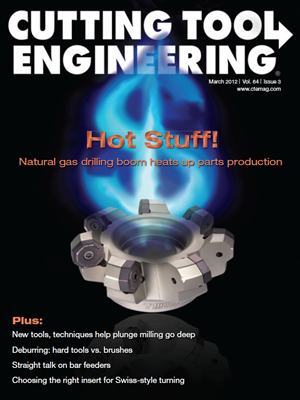
All images Courtesy of S. Smith
Figure 1. Supporting machine tool beds at the Airy points minimizes deflection, which is greatly exaggerated in this illustration.
A machine tool bed serves several important functions. It supports the machine’s moving elements and supports them in geometric relation to each other. The relationship between the moving elements is more important than the relationship between the moving elements and the ground the machine is based on.
It is typically desirable for the bed to be as flat as possible, which requires considerable effort to scrape or grind the surfaces on which the guide ways are mounted. The bed should be stiff, thermally stable and able to absorb or dissipate vibration. When the machine is installed, the bed must be aligned.
Bed flatness depends on the connection between the bed and the foundation. In geometry, three noncollinear points are enough to define a plane. If the machine bed is very stiff, then three connection points between the bed and the foundation are sufficient to support the bed. In such a case, machine accuracy does not depend on foundation accuracy. Machines with work spaces up to a cubic meter or more can be found with three mounting points.
Even a stiff bed is not infinitely stiff. The bed sags a little between the mounting points. The sag can be minimized by placing the supports, or feet, at the Airy points (Figure 1). (Airy points are used in precision measurement to support a length standard in such a way as to minimize bending or drooping.) The distance between the supports (d) should be about 60 percent of the bed length (L).
The distance from either end of the bed to the supports should, therefore, be about 20 percent of the bed length. In Figure 1, two of the three supports should be aligned on Airy points, and the third support should be centered on the bed (see Figure 2 on page 24). With three-point mounting, machine alignment is maintained, even if the temperature changes and the bed has a different coefficient of thermal expansion than the floor.
As a machine gets larger, it becomes unfeasible to support the machine on three points, and more feet are required. A large machine may have 20 or more feet. When the machine is installed, screws adjust the portion of the machine weight carried by each foot, and bed flatness and straightness is repeatedly measured.
With larger machines, the bed derives some of its stiffness from the foundation, which is typically comprised of thick slabs of reinforced concrete. The larger the machine, the thicker and stiffer the slabs should be. In some cases, mounting bolts embedded in the foundation are used to pull the bed toward the floor.
Unfortunately, for machines with more than three mounting points, the geometric accuracy of the machine changes as the foundation changes. Curing and settling of the concrete can change machine alignment over a period of months or years. Temperature changes on a 1-day time scale also cause the machine to move with respect to the foundation, reducing machine accuracy.

Figure 2. Top view of mounting locations for three-point bed support.
At this scale, calculations of bed and foundation deflection in response to machine load begin to resemble those used for foundations of buildings, roads and railroads. Classic equations developed in 1926 by H.M. Westergaard for calculations like these consider the size and weight of the loads, geometry of the mounting pads, concrete thickness, reinforcement, modulus of elasticity and reaction of the subgrade.
For extremely large machines, even the curvature of the Earth can be a substantial fraction of the tolerance. A machine with a travel of 40m might have a straightness tolerance of 160µm, and the Earth’s curvature over this distance is 32µm. (See “Measurement techniques for determining the static stiffness of foundations for machine tools,” A. Myers, S.M. Barrans and D.G. Ford, Journal of Physics: Con- ference Series 13, 2005, pgs. 410 to 413.) CTE
About the Author: Dr. Scott Smith is a professor and chair of the Department of Mechanical Engineering at the William States Lee College of Engineering, University of North Carolina at Charlotte. Contact him via e-mail at [email protected].
Related Glossary Terms
- flat ( screw flat)
flat ( screw flat)
Flat surface machined into the shank of a cutting tool for enhanced holding of the tool.
- modulus of elasticity
modulus of elasticity
Measure of rigidity or stiffness of a metal, defined as a ratio of stress, below the proportional limit, to the corresponding strain. Also known as Young’s modulus.
- precision machining ( precision measurement)
precision machining ( precision measurement)
Machining and measuring to exacting standards. Four basic considerations are: dimensions, or geometrical characteristics such as lengths, angles and diameters of which the sizes are numerically specified; limits, or the maximum and minimum sizes permissible for a specified dimension; tolerances, or the total permissible variations in size; and allowances, or the prescribed differences in dimensions between mating parts.
- static stiffness
static stiffness
Relates to the machine tool and is measured in pounds per inch. Static stiffness indicates how many pounds of force it takes to deflect the spindle a linear distance of 1" in a given direction. See dynamic stiffness; stiffness.
- stiffness
stiffness
1. Ability of a material or part to resist elastic deflection. 2. The rate of stress with respect to strain; the greater the stress required to produce a given strain, the stiffer the material is said to be. See dynamic stiffness; static stiffness.
- tolerance
tolerance
Minimum and maximum amount a workpiece dimension is allowed to vary from a set standard and still be acceptable.

